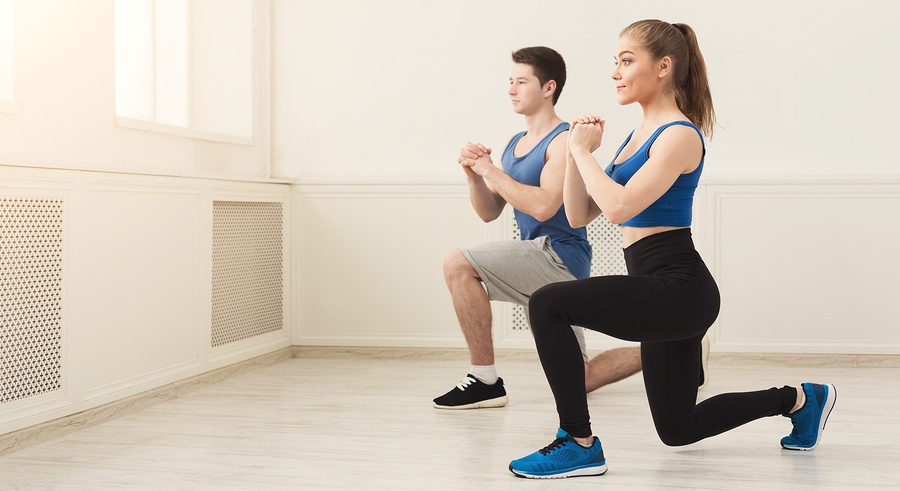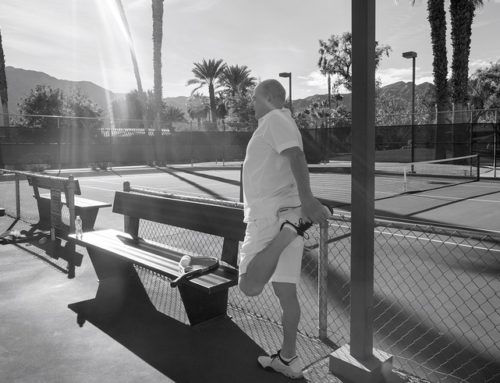Just like reading, writing, and arithmetic, the finer points of fitness can fade from memory after a summer of fun. To refresh your fall fitness routine, check out our expert tips for performing four of the most common (and effective) exercises.
Squats
Muscle Groups Targeted: Glutes, Hamstrings, Quadriceps
Trainer Tips: Squats, sometimes called the “king of exercises”, are excellent for sculpting your buttocks and thighs. However, squats can feel unnatural and lead to back, hip, and knee pain if performed incorrectly. To begin, stand with your feet slightly wider than hip-width. Keeping your weight in the heels, send your hips back like you’re about to sit in a chair. Lower your body until your thighs are approximately parallel to the floor, then return to standing by pushing your heels into the floor and squeezing your glutes.
Modifications: If squatting hurts your joints, try a sit and stand. Sit in a sturdy chair with your legs hip-width, knees aligned over ankles. Stand up by engaging your glutes and keeping your weight in the heels, then lower to a seated position by sending your hips backward and engaging your glute muscles. You can also place pillows on the chair to make the movement easier.
Progressions: If bodyweight squats are getting too easy, there are numerous ways to make squats more challenging. You can pick up a set of dumbbells, place a barbell on your back (avoiding bony areas), or experiment with variations like a narrow-stance or a wide-stance. The sky’s the limit.
Lunges
Muscle Groups Targeted: Calves, Hamstrings, Quadriceps, Glutes
Trainer Tips: Begin by standing in a split-stance, legs in-line with your hips, front knee aligned over your front ankle. As you descend into the lunge, keep your chest up and your shoulders over your hips. At the bottom of the lunge, your legs should create two, 90-degree angles. Remember, lunges are an up and down motion, not forward and back, so be an elevator, not an escalator!
Modifications: Lunges challenge your balance, so grab a wall or chair for balance support. If you’re having trouble keeping your front knee aligned over the front ankle, place your toe against a wall. This action will ensure that your knee stays in good alignment and help you practice proper lunge form.
Progressions: Just like squats, picking up extra weight is an easy way to make lunges more challenging. You can also experiment with lunge variations, including alternating front and back lunges, side lunges, and even plyometric (jumping) lunges!
Pushups
Muscle Groups Targeted: Chest, Shoulders, Triceps, Abdominals
Trainer Tips: The key to a good pushup is proper alignment. Begin by placing your hands slightly wider than your shoulders and make sure that your body is one unit from the top of your head to your knees (when performing knee pushups) or heels (when performing full pushups). As you lower your body, keep your abdominals engaged and your head in neutral alignment (avoid diving the head towards the floor). To ensure you’re lifting and lowering the body as one unit, perform pushups in front of a mirror.
Modifications: Pushups can be performed in a “table top” position by placing the knees directly under your hips. This variation targets the upper body without added pressure on the back and abdominals. Pushups can also be performed in a standing position using a sturdy wall. No matter which variation you choose, practice engaging your abdominals and lifting and lowering the body as one strong unit.
Progressions: When traditional pushups get stale, you can spice up this exercise by placing your feet on a sturdy bench, performing pushups on a medicine, stability, or BOSU ball, or trying some plyometric (clapping) pushups.
Planks
Muscle Groups Targeted: Abdominals, Back, Shoulders, Triceps, Quadriceps, Hamstrings, Glutes, Chest
Trainer Tips: Planks are a phenomenal total body exercise for creating core strength and stability. Just like pushups, the key to a good plank is proper alignment. Begin by placing your elbows on the floor, directly under your shoulders. Clasp your hands, creating a pyramid shape with your arms. Lift up onto your toes, locking your body into one long “plank” from the top of your head to your heels. While holding plank, avoid lifting or sagging the hips. When performed properly, you should feel your abdominals working hard.
Modifications: If you’re not ready to lift your entire body, keep your knees on the floor. Concentrate on lifting and squeezing the abdominals while keeping your body in-line from the top of your head to your knees.
Progressions: For an added challenge, perform straight-arm planks with your hands aligned under your shoulders, or experiment with other variations, such as side and reverse planks.
Need extra help? Schedule a one-on-one appointment with one of our Virtual Fitness Specialists. Video conferencing allows our fitness experts to watch your form and help you perfect it, as well as develop an effective, safe routine designed just for you!





